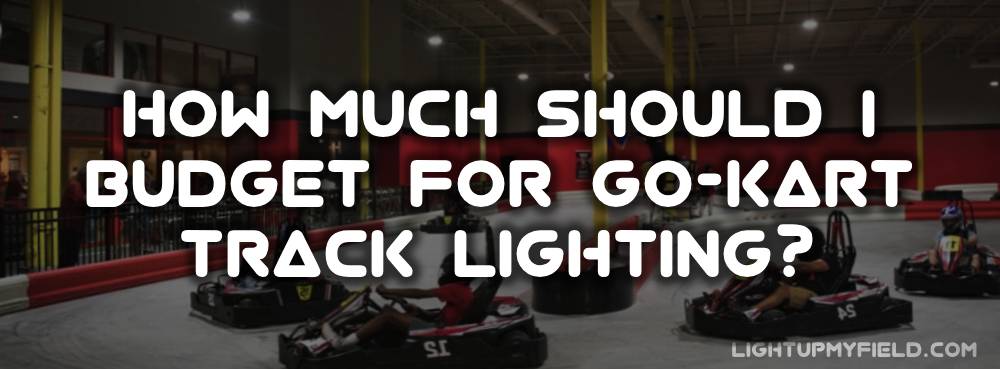When you start planning a go-kart track — whether it’s a fun local spot for weekend racers or a professional-level facility — one of the first big expenses that comes to mind is lighting. It’s what lets your track come alive after sunset, keeps racers safe, and makes the whole space look professional. But figuring out how much to budget for go-kart track lighting isn’t always straightforward. Prices can swing dramatically depending on the track size, lighting system, and performance level you want.
Let’s break it down step by step so you can get a better idea of what kind of investment you’re looking at — and where you can save money over time without cutting corners on performance or safety.
Table of Contents
ToggleImportance of the Cost of Go-Kart Track Lighting
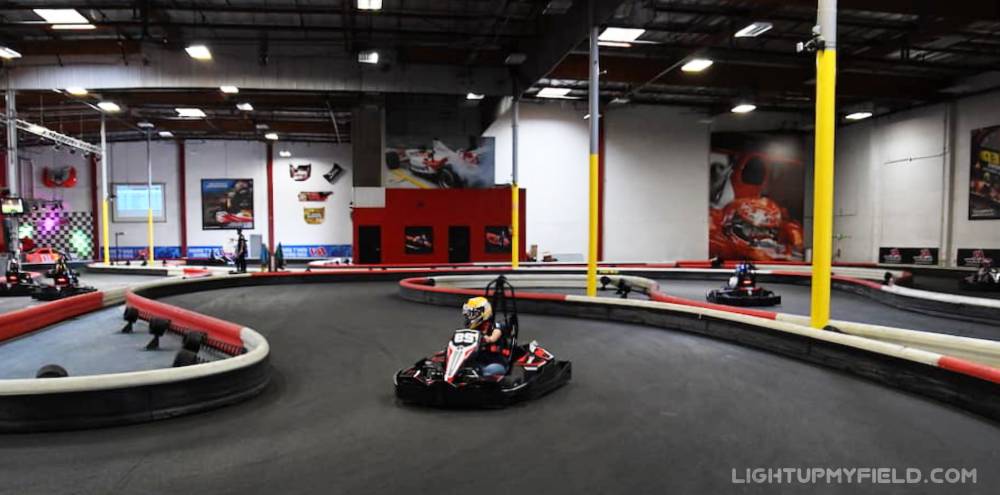
Lighting isn’t just about being able to race at night. It’s a big part of how your go-kart facility runs, affects your operating costs, and even shapes how your customers experience the track. The upfront cost is one thing, but the long-term operation and maintenance expenses also play a major role.
Operating Expenses and Energy Use
Lighting for a go-kart track can make up a surprisingly large part of your monthly electricity bill. A medium-sized track might need between 80 and 120 LED fixtures, each running several hundred watts. If those lights run for five hours a night, six days a week, you’re talking about tens of thousands of kilowatt-hours per year. Even small differences in efficiency add up fast — the difference between a 500W LED fixture and a 1000W metal-halide one could mean hundreds of dollars saved every month.
That’s why many new tracks go straight for LED lighting. LEDs use about 60–70% less energy than traditional metal-halide lights, while providing better brightness and color rendering. They also don’t require warm-up time and are easier to control with smart systems.
Maintenance and Longevity
Lighting maintenance costs are another big consideration. Metal-halide lamps usually need bulb replacements every 2,500 to 3,000 hours, while LED lights can last 50,000 hours or more — that’s easily a decade of operation with minimal maintenance. The longer lifespan means fewer interruptions, lower labor costs, and less downtime for your facility.
Over ten years, choosing efficient, low-maintenance fixtures can easily save you 30–40% in total ownership cost compared to older lighting technologies. So while LED systems might seem more expensive upfront, they’re often cheaper in the long run.
Customer Experience and Safety
Good lighting doesn’t just reduce accidents; it improves the entire racing experience. If your lighting is uneven or dim, drivers can’t see corners clearly, spectators can’t follow the action, and photos or videos look dull. Investing in a proper lighting setup creates a more exciting, professional atmosphere — which usually means more repeat visitors and better reviews.
Average Cost of Go-Kart Track Lighting
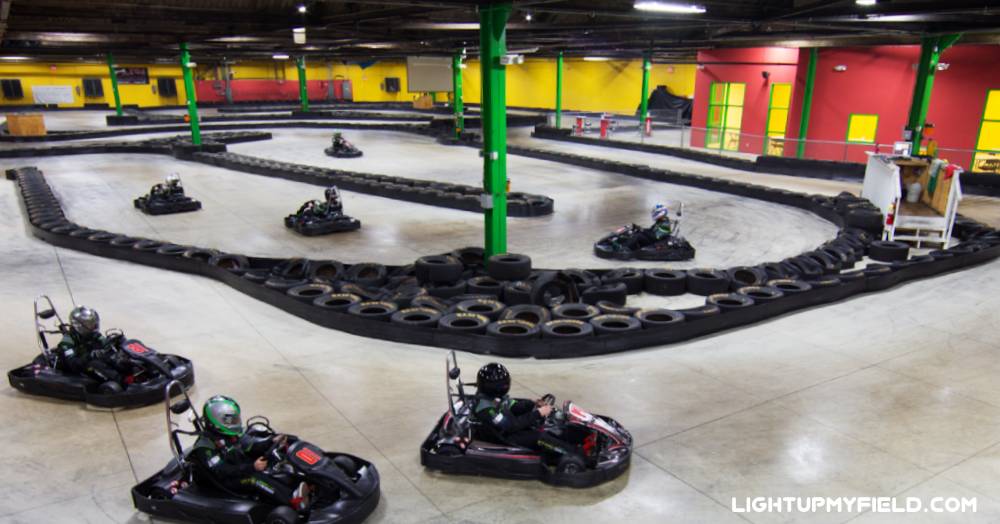
So, how much should you really budget for go-kart track lighting? The truth is, there’s no one-size-fits-all answer. The final number depends on a mix of factors — your track’s size and layout, whether it’s indoor or outdoor, and what kind of karting experience you’re offering, from casual recreational racing to full-on competitive events. Let’s look at what you can expect for different scales of operation and what actually drives those numbers.
Small-Sized Go-Kart Tracks
If you’re running a smaller recreational track, maybe something around 200 to 300 meters long and about 6–8 meters wide, your lighting setup doesn’t need to be overly complex — but it still has to deliver enough brightness and uniformity for safe night racing. You’ll typically need somewhere between 20 and 40 high-quality LED floodlights, depending on how the corners and straights are arranged.
A decent starting point would be around $25,000 to $50,000 total for installation. That includes the fixtures, poles (usually around 6–8 meters tall), electrical wiring, and installation labor. The price can climb if your site needs extra electrical infrastructure or trenching work. If your facility runs mostly in the daytime, you might only aim for 100–150 lux on the track surface — just enough to make evening sessions comfortable without going overboard.
However, if you plan to host nighttime events or parties, it’s smart to invest in slightly brighter LEDs — say 150–200 lux average — and add a few extra poles near tighter turns or pit areas. Each additional LED fixture (around 300–500W) could add roughly $700–$1,500 depending on brand and efficiency. It might seem small, but lighting those tricky corners properly can make a big difference in safety and visibility for drivers.
Medium-Sized Go-Kart Tracks
For most commercial tracks — typically 400 to 600 meters long — you’re stepping into a different lighting category. These venues often need around 50 to 80 fixtures to get consistent, professional-level lighting across the entire track. The total project cost for something this size usually falls between $70,000 and $120,000, depending on how bright and uniform you want it to be.
If you want your go-kart track lighting to meet semi-professional racing standards, aim for 200–300 lux across the driving surface, with a uniformity ratio (the balance between the brightest and darkest spots) of about 0.6 to 0.7. That means no dark patches or blinding glare — just clean, even lighting so racers can see every corner and braking zone. Achieving that balance requires proper lighting design, often involving a mix of wide-beam and narrow-beam floodlights mounted at different heights and angles.
The level of brightness also affects how many poles you’ll need. For medium-sized tracks, poles between 8–10 meters tall are common, and each one might support two to four LED fixtures. Taller poles help spread the light more evenly, reducing the total number of fixtures required — though installation and structural work can add $1,000–$2,000 per pole to your budget. Still, that extra height is often worth it for smoother illumination and less glare on the drivers’ visors.
If your facility hosts night races, endurance events, or rental kart competitions, lighting uniformity becomes even more crucial. In those cases, it’s worth investing in higher-end LED floodlights with CRI (Color Rendering Index) above 80, which makes colors pop and improves driver visibility. It also helps spectators and cameras capture better visuals — which is a plus for marketing and social media.
Large or Professional-Level Tracks
Now, for large outdoor go-kart circuits — we’re talking 700 meters or more, possibly with complex turns, multiple lanes, or spectator areas — lighting becomes a major investment. Costs for professional-level setups usually range from $150,000 to $300,000 or more, depending on your ambitions and the level of competition your facility aims to support.
At this scale, you’re looking at 60 to 100+ LED floodlights, often mounted on 12 to 15-meter poles. Each high-power LED fixture can range from 600 to 1200 watts, delivering 40,000 to 100,000 lumens of light output. For a competitive-grade track, you’d typically target illumination levels between 400 and 500 lux, which is bright enough for professional racing and even televised events.
Professional lighting systems also pay close attention to glare control and spill light management. You don’t want to blind drivers or annoy nearby residents, so quality optics and beam shaping become crucial. That’s part of why these systems cost more — they’re engineered for performance and precision.
Many large go-kart facilities also go beyond just white lighting. They integrate DMX or DALI control systems, which allow you to adjust brightness, colors, and effects with software or even from a smartphone app. This opens up a lot of flexibility: dimming the lights for practice sessions, turning up the brightness for competitions, or creating custom light shows for events. While these advanced systems can add 10–20% to your upfront cost, they can boost your venue’s appeal for corporate events, parties, or special tournaments, giving you extra revenue streams.
Some operators even pair their lighting with energy monitoring systems or motion-based automation, which automatically adjusts brightness when no one’s on track. These features might sound fancy, but over time, they can help trim 20–30% off your energy bills.
Why the Range Matters
It’s worth mentioning that lighting costs can vary a lot from one project to another, even for similar-sized tracks. The geographic location plays a role too — installation costs in California or New York might be 20–30% higher than in smaller states because of labor rates and permit requirements. The quality of your poles, cables, and electrical infrastructure also makes a difference. For example, upgrading to galvanized steel poles for outdoor durability can add several thousand dollars but save you from corrosion-related replacements later.
So when you’re planning your budget, it’s better to think in terms of total system cost, not just the price of fixtures. That means including everything — lights, poles, foundations, wiring, controls, installation, and future maintenance. On average, the fixtures themselves might make up 60–70% of the total budget, while installation, wiring, and control systems cover the remaining portion.
| Track Size | Track Length | Number of Fixtures | Average Cost (USD) | Pole Height | Brightness (Lux) | Key Notes |
|---|---|---|---|---|---|---|
| Small | 200–300 m | 20–40 LED floodlights | $25,000–$50,000 | 6–8 m | 100–200 lux | Each extra LED fixture: $700–$1,500 |
| Medium | 400–600 m | 50–80 LED floodlights | $70,000–$120,000 | 8–10 m | 200–300 lux | Poles add $1,000–$2,000 each |
| Large / Professional | 700 m+ | 60–100+ LED floodlights | $150,000–$300,000+ | 12–15 m | 400–500 lux | Advanced control systems +10–20% cost |
Factors Affecting the Go-Kart Track Lighting Cost
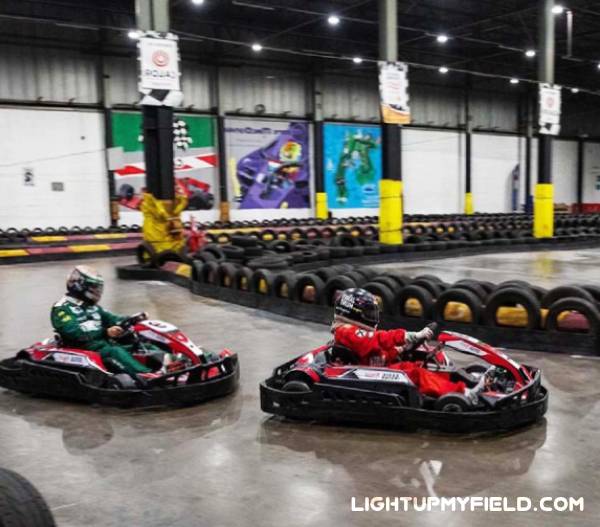
Every go-kart track is unique, and so are its lighting needs. The final cost of installing or upgrading a lighting system depends on a mix of technical requirements, track layout, and desired user experience. Understanding the main factors can help you plan a realistic budget and avoid surprises down the line.
Required Lux or Foot-Candle Levels
Lighting performance is usually measured in lux (lumens per square meter) or foot-candles in the U.S. For a casual indoor go-kart facility, you might only need 150–200 lux, which is enough for safe recreational racing. Outdoor tracks, especially those hosting competitive or televised events, often require 400–500 lux or more to ensure visibility for drivers, spectators, and cameras.
The higher the lux requirement, the more fixtures you’ll need, the higher the wattage per fixture, and the more robust your electrical setup must be. A jump from 200 lux to 400 lux can easily double your number of lights and increase your energy demand by 50–70%, which translates directly into higher costs. Choosing the right lux level is about balancing safety, experience, and budget.
Indoor vs. Outdoor Setup
Whether your track is indoors or outdoors has a big impact on your lighting budget. Outdoor tracks require weatherproof fixtures, taller poles (often 10–15 meters), and extra power to cover wider areas. You’ll also need to consider glare reduction and spill light management, especially if your track is near residential areas. All these factors add to the cost.
Indoor tracks, on the other hand, generally need fewer fixtures because mounting heights are lower and the light reflects off walls and ceilings. That said, indoor facilities must account for ceiling design, glare, and reflective surfaces, which can complicate the layout. Even though indoor lighting is typically cheaper per square foot, planning for uniformity and safety is just as important, especially in tight corners or pit lanes.
Type of Lighting Technology
Metal-halide lamps were once the go-to solution for go-kart tracks, but today, LED technology dominates. LEDs have a higher upfront cost — about 20–40% more than metal-halides — but they use significantly less energy and have much longer lifespans, often 50,000 hours or more. They also turn on instantly, eliminating warm-up time, which is great for event scheduling and flexibility.
A high-quality LED floodlight generally costs between $800 and $2,000 per fixture, depending on power and lumens output. Traditional lamps might cost less initially but can double your electricity bills over time, especially for tracks that run late evening sessions.
Lighting Control Systems
Smart lighting controls are increasingly common in modern go-kart tracks. Systems with dimming, motion sensors, or remote monitoring can slightly increase upfront installation costs but save big in the long run. For instance, scheduling lights to dim during low-traffic hours or switching to “race mode” only when karts are on track can reduce energy consumption by up to 30%.
Advanced control systems like DMX or DALI also allow you to adjust color, brightness, and effects for special events or branding, which can make your facility more attractive for private bookings or corporate events.
Color Lighting and Special Effects
Adding colored LEDs or dynamic lighting effects can enhance the atmosphere and brand your track. For example, RGB floodlights around the pit area or finish line can create a high-energy look that draws in customers. These systems usually cost 20–50% more than standard white LED setups, depending on complexity.
For tracks that host special events, parties, or competitions, the added visual appeal can be worth the investment. It not only improves the racing experience but also helps in marketing, photography, and video content.
Solar Power and Off-Grid Systems
Some tracks, particularly in rural areas or locations with high electricity rates, are considering solar-powered lighting systems. Solar setups require panels, batteries, and controllers, which add to the initial investment — often 25–40% more than a traditional grid-connected system.
However, these systems can dramatically reduce ongoing electricity costs. A well-designed solar-assisted LED setup can cover most, if not all, of your nighttime energy needs. Depending on local conditions and energy costs, the investment can pay for itself in 5–7 years while providing energy independence and sustainability branding for your facility.
Other Cost Influencers
Other elements that affect the final price include the track layout, the number of corners versus straightaways, and the placement of spectator areas. Tracks with complex curves require more fixtures to prevent dark spots, while straight tracks might need fewer but more powerful lights. Adding pit lane, paddock, or parking area lighting also increases both fixture and installation costs.
The takeaway is that every decision — from lux levels to technology, from indoor/outdoor setup to solar integration — directly influences your overall budget. Careful planning and understanding of these factors help you avoid unexpected expenses and ensure your go-kart track lighting performs efficiently for years to come.
How to Save Running and Maintenance Costs of Go-Kart Track Lighting
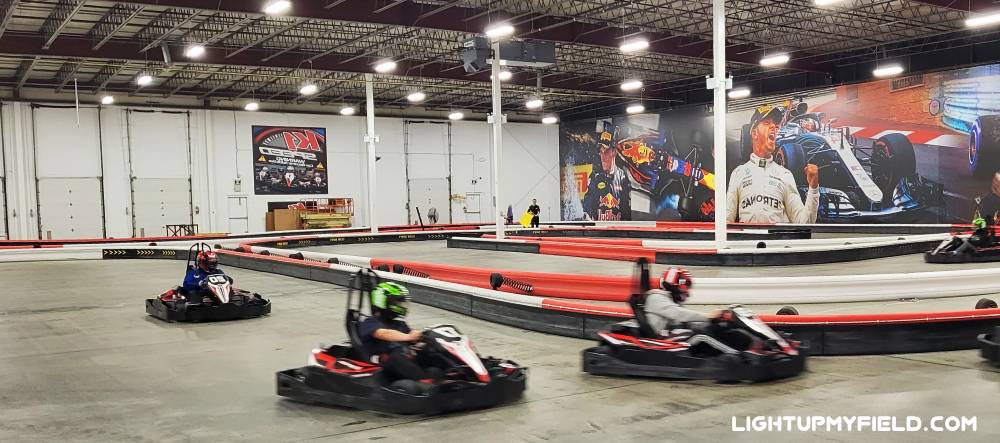
Once your go-kart track lighting system is installed, the next big concern is how to keep operating and maintenance costs manageable. Even the most efficient LED setup can become expensive if it isn’t managed smartly. The key is to combine good fixture selection, smart controls, and regular upkeep with a few strategic choices that cut energy waste.
Choose Efficient Fixtures
Not all LED floodlights are built the same. When selecting fixtures for your go-kart facility, focus on lumens per watt (lm/W) ratings — ideally 130 lm/W or higher. Higher lm/W means you get brighter light for the same energy use, which directly lowers electricity bills. For example, switching from a 100 lm/W fixture to a 150 lm/W model can reduce power consumption by roughly 30% while maintaining the same track brightness.
Investing in high-efficiency LEDs may cost a bit more upfront, but they pay off quickly through reduced energy usage and less frequent replacements. High-quality fixtures also maintain consistent color temperature and brightness, which keeps your racing surface well-lit and safe for drivers.
Use Smart Lighting Controls
Smart lighting controls are one of the easiest ways to reduce running costs. Systems with dimming capabilities, motion sensors, or automated schedules let you tailor lighting output to real-time needs. For example, during slower practice sessions or maintenance hours, you can dim the lights to 50% without sacrificing visibility.
Modern go-kart facilities often use programmable lighting schedules, which automatically turn lights on and off according to track hours or event calendars. This avoids leaving lights on unnecessarily and can reduce energy bills by 20–30% annually. Advanced DMX or DALI systems also allow for adjustable brightness zones, so corners or pit areas can be brighter than straightaways only when needed, optimizing both safety and cost.
Maintain Fixtures Regularly
Even though LEDs are low-maintenance compared to traditional lamps, regular upkeep is still necessary. Outdoor fixtures especially collect dust, dirt, and insects, which can cut brightness by up to 20% over time. A simple wipe-down every few months can maintain consistent illumination and maximize efficiency.
Regular inspections also help catch loose wiring, corrosion, or faulty drivers before they become expensive repairs. Scheduling a semi-annual maintenance check keeps the track operating safely and prevents sudden outages during critical race events.
Invest in Quality from the Start
It might feel tempting to save money upfront by buying cheaper lighting systems, but that often backfires. Low-cost fixtures tend to fail sooner, may flicker or dim unevenly, and often require rewiring or replacement within a few years.
Spending a bit more on reputable brands and weatherproof fixtures ensures a longer lifespan, more consistent performance, and less hassle with repairs. In the long run, a well-designed, high-quality system can save thousands in maintenance labor and replacement costs while giving your facility a professional look and safer environment.
Explore Incentives or Rebates
Depending on your location, energy-efficiency rebates and tax incentives can help offset part of your lighting investment. Some utility companies provide rebates per fixture installed or per kilowatt-hour saved, which can cut your payback period by months or even years.
For example, a track upgrading 50 LED floodlights might receive rebates ranging from $50 to $300 per fixture, depending on regional programs. Additionally, some states or municipalities offer incentives for commercial or recreational facilities switching to high-efficiency or solar-assisted lighting, making energy-efficient upgrades even more affordable.
Seek Government Funding Opportunities
Beyond utility rebates, various government funding programs can help reduce the cost of upgrading or maintaining go-kart track lighting systems. Many federal, state, and local governments provide grants or low-interest loans for energy-efficient infrastructure projects, especially those that promote sustainability and reduce carbon emissions.
Programs such as the U.S. Department of Energy’s (DOE) Energy Efficiency and Conservation Block Grant (EECBG) or similar regional initiatives may offer funding assistance to small businesses, sports facilities, and recreational venues transitioning to LED or solar-powered lighting. In some countries, environmental agencies and development boards also support projects that incorporate renewable technologies or demonstrate community benefits.
Applying for these programs typically requires submitting details such as your facility’s energy consumption, projected savings, and sustainability goals. Partnering with lighting suppliers familiar with government grant documentation can simplify the process and increase your chances of approval.
By leveraging government funding along with rebates and incentives, you can significantly reduce your initial investment costs—sometimes by 30–60%—making it easier to install top-quality, energy-efficient lighting without stretching your budget.
Combine Strategies for Maximum Savings
The real power comes when you combine these approaches. Installing high-efficiency LEDs, pairing them with smart controls, maintaining them regularly, investing in quality upfront, and taking advantage of rebates and government funding can collectively reduce both running and maintenance costs by 40–50% compared to a conventional lighting setup.
Over time, these strategies don’t just save money; they also enhance the racing experience, keep your track safer, and extend the lifespan of your lighting infrastructure. Essentially, a smart approach to go-kart track lighting pays for itself in energy savings, lower maintenance, and fewer operational headaches.
Bringing It All Together
Budgeting for go-kart track lighting might seem complicated at first, but once you break it down, it’s mostly about finding the right balance between performance, efficiency, and upfront cost. For smaller recreational tracks, you might spend around $30,000–$50,000, while a mid-sized commercial facility could land closer to $100,000, and a large competition-level track might reach $200,000 or more.
The good news is that with modern LED systems and smart controls, you can keep your long-term energy and maintenance costs surprisingly low. Plus, great lighting doesn’t just help people see — it makes your track safer, more enjoyable, and a whole lot more attractive to visitors. In other words, investing wisely in your lighting system isn’t just about spending money — it’s about setting your go-kart facility up for years of reliable, exciting, and efficient operation.

